Skewer
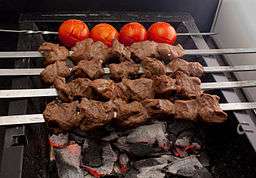

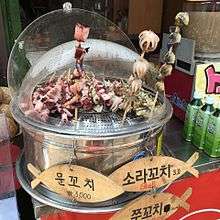
A skewer is a thin metal or wood stick used to hold pieces of food together. They are used while grilling or roasting meats, and in other culinary applications. Skewers are often used for kebab dishes.
Metal skewers are typically stainless steel rods with a pointed tip on one end and a grip of some kind on the other end for ease of removing the food. Non-metallic skewers are often made from bamboo; however, any suitable wood may be used. Prior to grilling, wooden skewers must be soaked in water to avoid burning.
Other uses
Small, often decorative, skewers of glass, metal, wood or bamboo known as "olive picks" are used for garnishes on cocktails and other alcoholic beverages. Many types of snack food are sold and served "on a stick" or skewer, especially at outdoor markets, fairs, and sidewalk or roadside stands.
List of skewered foods
This is a list of skewered dishes by country, which includes kebabs.
Afghanistan
Africa
| Name | Image | Description |
|---|---|---|
| Kyinkyinga | A common kebab in West Africa prepared with beef steak or liver that is coated in peanut flour and roasted on skewers.[1] | |
| Sosatie |  |
A dish of the Cape Malay people of South Africa[2] |
Armenia
Kebabs in Armenia are prepared of ground meat spiced with pepper, parsley and other herbs, and roasted on skewers.
Azerbaijan
| Name | Image | Description |
|---|---|---|
| Khan kebab | ||
| Lyulya kebab |  |
(Russian: люля-кебаб) – served skewered or wrapped in lavash bread[3] |
| Sham kebab | ||
| Tava kebab |
China
Chuanr (Chinese: 串; pinyin: chuàn), often referred to as "chua'r" throughout the north, or kawap (كاۋاپ) in Uyghur, is a variation of kebab originating from the Uyghur people in the western province of Xinjiang and a popular dish in Chinese Islamic cuisine. The dish has since spread across the rest of the country and become a popular street food.
Although the most traditional form of chuanr uses lamb or mutton, other types of meat, such as chicken, beef, pork, and seafood, may be used as well. Small pieces of meat are skewered and either roasted or deep-fried. Common spices and condiments include cumin called "ziran", pepper, sesame, and sesame oil.
| Name | Image | Description |
|---|---|---|
| Chenjeh kabab |  |
Uyghur: Kewap, Chinese: 串儿 Chuanr or 羊肉串 Yangrouchuan - The most popular Xinjiang dish in China, being chunks of mutton or mutton fat pierced on metal (or wood or bamboo) skewers, grilled on a coal-fired barbecue, and served with cumin and chili paste. Across Xinjiang, and neighbouring regions such as Kyrgyzstan, the mutton fat is valued equivalent to or more than the meat itself, as it provides sufficient energy during the harsh winter months. It has also become a popular street food all over North and West China, where a wide variety of foods are cooked in such a manner. Chuanr was traditionally made from lamb (yáng ròu chuàn, 羊肉串), which is still the most common, but now, chicken, pork, beef, and various types of seafood are also used. It is typically roasted over charcoal or electric heat, but It is sometimes also cooked by deep frying in oil (popular in Beijing). Pictured are barbecued chuanr-style lamb kebab sticks sold by a street vendor |
Cyprus
| Name | Image | Description |
|---|---|---|
| Sheftalia | 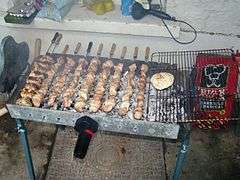 |
A traditional Cypriot sausage made of ground pork or lamb and wrapped in caul fat that is served alone or in a pita, usually with tomato, cucumber, parsley, and lemon |
| Souvlaki | 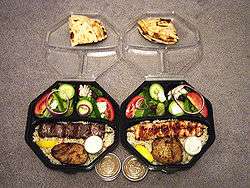 |
Skewers consisting of pork, chicken or lamb that is barbecued.[4] Pictured is a souvlaki platter. |
Greece
Excavations in Santorini, Greece, unearthed stone sets of barbecue for skewers used before the 17th century BC. In each pair of the supports, the receptions for the spits are found in absolute equivalence, while the line of small openings in the base formed a mechanism to supply the coals with oxygen so that they remained alight during its use.[5] Mycenaean Greeks used portable tray as grills. These trays were rectangular ceramic pans that sat underneath skewers of meat but it is not clear whether these trays would have been placed directly over a fire or if the pans would have held hot coals like a portable barbecue pit.[6][7] Homer in Ilad (1.465) mentions pieces of meat roasted on spits (οβελός).[8][9][10][11] In Classical Greece, a small spit or skewer was known as ὀβελίσκος (obeliskos),[12][13] and Aristophanes mentions such skewers being used to roast thrushes.[14]
While the history of street foods in Greece goes back to ancient times, the iconic Greek gyros and souvlaki as it is known today arose only following the Second World War. Introduced to Athens in the 1950s by immigrants from Turkey and the Middle East, gyros was originally known simply as döner kebab. It is typically served as a sandwich rolled in pita bread, or on a plate, with french fries and various salads and sauces such as tzatziki. Later in the 1960s, vendors also began selling dishes in the same style made with souvlaki, which resembles Turkish shish kebab, but is usually made with pork.[15]
Around the same time, the Greek name gyros replaced döner kebab, and the dish became popular in New York City and various parts of the world.[16]
In contrast to other areas of Greece, in Athens, both types of sandwich may be called souvlaki, with the skewered meat being called kalamaki.
Although gyros is unquestionably of Middle Eastern origin, the issue of whether modern-day souvlaki came to Greece via Turkish cuisine, and should be considered a Greek styling of shish kebab, or is a contemporary revival of Greek tradition dating as far back as 17th century BC Minoan civilization,[17] is a topic of sometimes heated debate, at least between Greeks and Turks.[18] While English speakers may refer to souvlaki skewers as kebabs,[19] they are not properly called that in Greece.
| Name | Image | Description |
|---|---|---|
| Gyros | 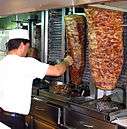 |
Made from chopped meat, usually pork or chicken, formed into a large loaf for slow-roasting on a vertical rotisserie cooker, the auto-donner. (See also doner kebab.) Thin portions are shaved off and served in a pitta bread with onion and Greek yogurt-cucumber-garlic sauce, tzatziki. Popularized in US by Greek restaurateurs in the Greektown, Chicago neighborhood. |
| Souvlaki | Souvlaki (skewer) consists of small skewers of meats such as chicken[20] and pork, barbecued, then served plain, in a pitta, or with salad. Chicken and lamb are also sometimes used. It is sometimes served on a skewer, or as a dinner in combination with rice, potatoes, and tzatziki sauce. |
India
| Name | Image | Description | |
|---|---|---|---|
| Bihari kabab | Skewered pieces of meat marinated in spice. Originally a dish from the non-vegetarian cuisine, Muslims invented Bihari kabab of the North Indian state of Bihar as it is made out of beef . It has spread to other countries.[21] | ||
| Boti kebab |  |
A mutton kebab.[22] Boti kebab is pictured at the bottom of the image | |
| Achari Tikka | |||
| Chicken tikka | .jpg) |
Another tandoori kebab, made of cubed chicken marinated with yogurt and spices[23] | |
| Dora kabab [24][25] | |||
| Galawat kabab | A variant of Shami kebab made without any admixture or binding agents and comprising just the minced beef (Muslim origin) and the spices. Speciality of Lucknow. | ||
| Hariyali kabab | Punjabi style chicken tikka or kabab made with combination of mint and coriander | ||
| Kakori kabab | Made of minced beef meat with spices, a specialty of Muslims of Lucknow & Delhi | ||
| Galauti kebab | A smoked patty prepared using leg of lamb that includes onion, garlic, ginger, saffron and spices, which is cooked on a griddle[26] | ||
| Hariyali kebab | A vegetarian kebab prepared using lentils and spinach[27][28] | ||
| Tangri kebab | Chicken legs roasted on open fire with hot spices and laced with butter or ghee[29] | ||
| Kastoori kebab [30] | |||
| Dahi ke kabab [31] | |||
| Burra kebab [32][33] | |||
| Kalmi kebab |  |
A chicken kebab.[34] Kalmi kebab is pictured on the left in the image. | |
| Paneer kabab | Vegetarian kebab | ||
| Reshmi kabab | A traditional kebab of Mughlai cuisine that is prepared with marinated chicken, lamb or beef[35] | ||
| Shami kebab | 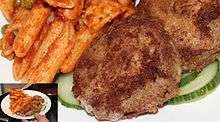 |
Made of minced beef, with paste of lentils and chopped onion and coriander and green chillies usually added to the mixture, which is kneaded in a disc-like shape and fried. Best results are obtained when fried in animal fat or ghee in a brass utensil over a coal fire. In some places, a binding agent is used to keep the kebab together. | |
| Shikampur kabab | |||
| Sutli Kebab |  |
Sutli kabab is made by wrapping a paste of meat & spices around a metal sheekh, tying it with a cotton thread & then heating it in a barbeque pit. Once the kabab is done, the thread is removed & the kabab is served.[36] |
Iran
| Name | Image | Description |
|---|---|---|
| Berenj goje kabab | ||
| Chelow kabab (rice with kebab) |  |
Is one of the most common forms of serving kebab in Iran which combines a variety of Persian kebabs with saffroned Basmati rice, lavash (a paper-thin bread), grilled tomato, raw onions, bell peppers, mushrooms and sumac and often a side of salad shirazi, mast-o-khiar and doogh (nowadays carbonated). An old Iranian tradition is to break a raw egg yolk over the rice, along with plenty of butter, just before serving, but not many follow this tradition anymore. |
| Dandeh kebab | ||
| Ghaz kabab | ||
| Joujeh kabab |  |
Grilled chicken on skewers |
| Kabab bakhtiari | Combination of Jujeh kabab and kabab barg | |
| Kabab barg |  |
Grilled marinated sirloin. |
| Kabab barreh | Grilled lamb, typically marinated in yogurt with parsley | |
| Kabab chenjeh | Grilled lamb prepared similar to shish kebab, without the vegetables | |
| Kabab digi | Pan Kabab | |
| Kabab hosseini | Lamb or beef cooked on skewers with onions, tomatoes and green peppers | |
| Kabab isphahani | ||
| Kabab Jigar-o Del-o Gholveh | ||
| Kabab kermanshahi | ||
| Kabab koobideh |  |
Ground beef or lamb (usually sirloin), often mixed with parsley and chopped onions |
| Kabab kurdi | Ground lamb or beef, onions, garlic, and tomatoes | |
| Kabab loghmeh | Minced lamb meatballs first fried and the grilled over charcoal fire, eaten with chopped parsley, chopped onions, and sumac. A summer outing favorite | |
| Kabab mahitabeh | Pan fried Kabab | |
| Kabab rashti | Also known as Kabab Shomali, includes almond & pistachio & barberry | |
| Kabab shamshiri | It is a kabab with kabab-barg on one side of skewer and kabab-kubideh on the other | |
| Kabab shirazi | ||
| Kabab soltani | Combination of kabab koobideh and kabab barg | |
| Kabab torsh |  |
(Gilan, northern Iran) Also called (tursh-e-kabab) grilled beef marinated in a mixture of pomegranate juice, crushed walnuts, parsley, crushed garlic, and olive oil |
| Kabab va nun ('Kabab with bread') | ||
| Kabab vaziri | ||
| Kabab-e donbalan | Lamb fries kabab | |
| Kababe shandiz | ||
| Sonnati kabab |
Japan
 Yakitori as street food, with a salty and sweet sauce
Yakitori as street food, with a salty and sweet sauce
Korea
In Korean cuisine, a traditional food category consisting of skewered food is called jeok. Varieties of jeok made with beef and vegetables are usually called sanjeok.
Kkochi is another term referring to skewered dishes, as well as the skewers themselves. Dak-kkochi is skewered chicken, and tteok-kkochi is skewered rice cakes.
Levant
Several varieties of kebabs can be found at most restaurants representing this region. Among the most common are shish taouk, which are grilled chicken skewers marinated in olive oil and spices, and lahem meshwi, charcoal-grilled skewers of prime lamb cubes lightly seasoned with herbs.[37]
Shawarma, although not considered a kebab in most countries of the Levant, is another very popular type of grilled meat preparation that characterizes this region.
Kebab halabi is a kind of kebab served with a spicy tomato sauce and Aleppo pepper, very common in Syria, Lebanon and the Galilee region in Northern Palestine, named after the city of Aleppo (Halab). Kebab halabi has around 26 variants[38] including:
| Name | Image | Description |
|---|---|---|
| Kebab hindi | Rolled meat with tomato paste, onion, capsicum and pomegranate molasses | |
| Kebab kamayeh | Soft meat with truffle pieces, onion and various nuts | |
| Kebab karaz | For cherry kebab in Arabic – meatballs (lamb) along with cherries and cherry paste, pine nuts, sugar and pomegranate molasses. It is considered one of Aleppo's main dishes, especially among Armenians. | |
| Kebab khashkhash |  |
Rolled lamb or beef with chili pepper paste, parsley, garlic and pine nuts. Pictured is Kebab khashkhash from Aleppo. |
| Kebab siniyye | For tray kebab in Arabic – lean minced lamb in a tray added with chili pepper, onion and tomato | |
| Kebab tuhal | Lamb rounds stuffed with parsley, hot green peppers and pine kernels[39] | |
| Shawarma | Similar to a doner kebab, made with chunks of lamb meat |
Nepal
A popular dish in Nepalese cuisine, as well as Newa cuisine, is sekuwa. It is a meat roasted in a natural wood/log fire in a real traditional Nepalese country style. At first while the meat is still in its raw stage is mixed with homemade natural herbs and spices and other necessary ingredients. Sekuwa could be of pork, lamb, goat or chicken, or a mixture. Sekuwa is very popular in Nepal, especially in the Eastern Nepal and Kathmandu. Tarahara, a small town in Sunsari District of Koshi State in the Eastern Nepal could be called as the sekuwa capital of Nepal.
Pakistan
| Name | Image | Description |
|---|---|---|
| Chapli kebab | 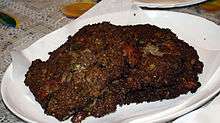 |
A delicacy of Pakistan from Khyber Pakhtunkhwa province – marinated beef in spices and deep fried flat.[40] In Pakistan, it is sometimes deep fried in animal tallow, and it is a common kebab.[lower-alpha 1] |
| Lola kabab/Gola kabab | Kabab of Pakistan and Afghanistan – rolled meatballs originating in Peshawar and Kandahar | |
| Seekh kebab |  |
Kebab of Pakistan – prepared with minced meat with spices and grilled on skewers. It is cooked in a Tandoor, and is often served with chutneys or mint sauce. It is often included in tandoori sampler platters, which contain a variety of tandoor cooked dishes. A seekh kebab can also be served in a naan bread much like döner kebab. Seekh kebabs are part of the traditional Pakistani diet. |
| Shami kebab |  |
Made of minced meat, with paste of lentils and chopped onion and coriander and green chillies usually added to the mixture, which is kneaded in a disc-like shape and fried. Best results are obtained when fried in ghee. In some places, a binding agent is used to keep the kabab together. |
| Tandoori kebab | Kabab of India/Pakistan – chunks or strips of meat marina | |
| Malai tikka | Kabab of Pakistan – chunks or strips of chicken marinated in a white yoghurt and garlic sauce and grilled | |
| Reshami kebab | Kabab of Pakistan – minced chicken adequately seasoned and then barbecued on a charcoal grill | |
| Bihari kebab | Kabab of Pakistan – chunks or strips of lean beef, marinated in a spicy yoghurt/chilli marinade and tenderized to perfection before slowly grilled on a charcoal flame |
Portugal
| Name | Image | Description |
|---|---|---|
| Espetadas | 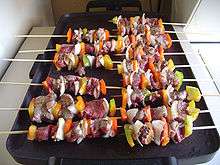 |
Meat skewer, usually beef[42] |
Scotland
| Name | Image | Description |
|---|---|---|
| Stonner kebab | A Scottish dish |
Spain
| Name | Image | Description |
|---|---|---|
| Pincho moruno | 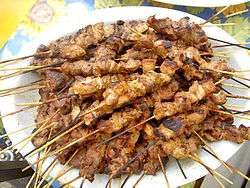 |
Meat skewer, usually made of chicken or pork, sliced in cubes, marinated in paprika and other spices. |
Turkey
| Name | Image | Description |
|---|---|---|
| Adana kebabı |  |
Also known as kıyma kebabı – kebab with hand-minced (zırh) meat mixed with chili on a flat wide metal skewer (shish); associated with Adana region although very popular all over Turkey.[43] |
| Ali Paşa kebabı (Ali Pasha kebab) | Cubed lamb with tomato, onion and parsley wrapped in filo[43] | |
| Alinazik kebab |  |
Ground meat kebab sautéed in a saucepan, with garlic, yogurt and eggplants added |
| Antep kebabı |  |
Half-fat minced meat mixed with thin slices of the same meat and made into balls and cooked between thick slices of eggplant |
| Bahçıvan kebabı[44] |  |
Boneless lamb shoulder mixed with chopped onions and tomato paste |
| Beykoz kebabı |  |
Tomato and onion flavoured lamb, wrapped in aubergine slices and garnished with lamb brains[43] |
| Beyti kebab |  |
Ground lamb or beef, seasoned and grilled on a skewer, often served wrapped in lavash and topped with tomato sauce and yogurt, traced back to the famous kebab house Beyti in Istanbul and particularly popular in Turkey's larger cities.[45] |
| Bostan kebabı | Lamb and aubergine casserole.[43] | |
| Cağ kebabı (spoke kebab) |  |
Cubes of lamb roasted first on a cağ (a horizontal rotating spit) and then on a skewer, a specialty of Erzurum region with recently rising popularity |
| Çardak kebabı[46] | Stuffed lamb meat wrapped in a crepe or filo. | |
| Ciğer kebabı (liver kebab) | Lamb liver kebab on a skewer (a.k.a. ciğer şiş) | |
| Çökertme kebabı | Sirloin veal kebap stuffed with yogurt and potatoes | |
| Çöp şiş (small skewer kebab) | A specialty of Selçuk and Germencik near Ephesus, pounded boneless meat with tomatoes and garlic marinated with black pepper, thyme and oil on wooden skewers[47] | |
| Doner kebab | .jpg) | |
| İskender kebap | Döner kebap served with yogurt, tomato sauce and butter, originated in Bursa. The kebab was invented by İskender Efendi in 1867. He was inspired from Cağ kebab and turned it from horizontal to vertical. | |
| İslim kebabı (stew) |  |
Another version of the aubergine kebab without its skin, marinated in sunflower oil[43][47] |
| Kağıt kebabı |  |
Lamb (or veal) cooked in a paper wrapping[47] |
| Kılıç şiş | Brochette of swordfish[43] | |
| Şiş köfte |  |
Also known as Shish köfte – minced lamb meatballs with herbs, often including parsley and mint, on a stick, grilled |
| Kuyu kebabı (pit kebab) | Prepared from the goat it is special for Aydın region, similar to tandır kebabı | |
| Kuzu şiş | Shish kebap prepared with marinated milk-fed lamb meat | |
| Manisa kebabı | This Manisa region version of the kebab is smaller and flat size shish meat on the sliced pide bread, flavored with butter, and stuffed with tomato, garlic and green pepper. | |
| Orman kebabı (forest kebab) | Lamb meat on the bone and cut in large pieces mixed with carrots, potatoes and peas[43] | |
| Patates kebabı[48] | Beef or chicken mixed with potatoes, onions, tomato sauce and bay leaves | |
| Patlıcan kebabı (aubergine kebab) | A unique kebap meat marinated in spices and served with aubergines, hot pide bread and a yogurt sauce[47] | |
| Şiş kebabı | .jpg) |
Prepared with fish, lamb or chicken meat on thin metal or reed rods, grilled[43][47] |
| Şiş tavuk |  |
Also known as Tavuk şiş or – Yogurt-marinated chicken grilled on a stick[47] |
| Sivas kebabı | Associated with the Sivas region, similar to Tokat kebab but especially lamb ribs are preferred and it also differs from Tokat kebabı on the point that there are no potatoes inside | |
| Tandır kebabı (tandoor kebab) | Lamb pieces (sometimes a whole lamb) baked in an oven called a tandır, which requires a special way of cooking for hours. Served with bread and raw onions.[43] | |
| Tas kebap (veal stew) |  |
Stewed meat in a bowl, beginning with the cooking of the vegetables in butter employing a method called yağa vurmak, ("butter infusion"), before the meat itself is cooked in the same grease |
| Testi kebabı (earthenware-jug kebab) | Ingredients are similar to çömlek kebabı, prepared in a testi instead of a güveç, generally found in Central Anatolia and the Mid-Western Black Sea region | |
| Tire kebabı | Minced meat cooked on sheesh and served with maydanoz and sauce, on top of special tire bread | |
| Tokat kebabı | Associated with the Tokat region, it is made with marinated lamb, grilled inside an oven, together with aubergines, tomatoes, potatoes, entire onions and garlics and served over a special flatbread called lavaş (a thicker yufka) and softened with the juice of the meat and tomatoes. | |
| Urfa kebabı | From Urfa, similar to Adana kebab, but not spicy | |
| Vali Kebabı
(Governor Kebab) |
 |
Others
| Name | Image | Description |
|---|---|---|
| Chislic | 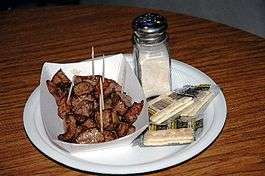 |
This is a migration of Russian culture into South Dakota by the German-Russian population. |
| Salmon kebab |  |
A kebab popular throughout the Pacific Northwest's United States coastal areas, especially during salmon runs[49] |
| Samak kebab | Grilled fish on a stick | |
| Satay | 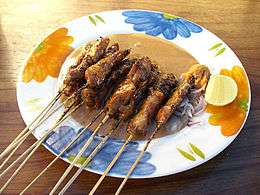 |
A Southeast Asian dish consisting of diced or sliced meat, skewered and grilled over a fire, then served with various spicy seasonings |
| Senjeh lebab | ||
| Shashlik |  |
Shashlyk, meaning skewered meat, was originally made of lamb. Nowadays it is also made of pork or beef depending on local preferences and religious observances. |
| Shishleek | A term with various uses: in Iran it refers to grilled baby lamb chops (usually from the leg), typically marinated; in Israel, to grilled turkey | |
| Suya: Kewap | A popular spicy meat kebab enjoyed by many across West Africa. Originally from Nigeria, this kebab has tastes of peanuts and spicy pepper and is sold by street vendors as a snack or entire meal. The kebabs are enjoyed with onion and bell pepper pieces. | |
| Kabab Memuleh b'hatzilim | A kebab balls made of minced beef, garlic, parsley, baharat, salt, black pepper, onions and cumin which stuffed with a mixture of fried or grilled eggplants and tahini.
Originally from Israel. | |
| Skewered goose liver | A dish from southern Tel Aviv. It is seasoned with salt and black pepper and sometimes with spices like cumin, cinnamon, paprika, nutmeg, allspice and turmeric. | |
| Yakitori |  |
A Japanese type of skewered chicken. The preparation of Yakitori involves skewering the meat with kushi (串?), a type of skewer typically made of steel, bamboo, or similar materials. Afterwards, they are grilled over a charcoal fire. During or after cooking, the meat is typically seasoned with tare sauce or salt. |
Gallery
 Turkish ciğer kebab
Turkish ciğer kebab Various kebabs at an Afghani restaurant in Geneva
Various kebabs at an Afghani restaurant in Geneva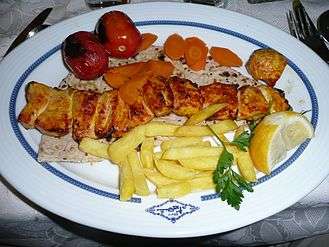 Iranian joujeh kabab
Iranian joujeh kabab- Kufta kebab Plate

 Döner kebab in a bun, as served in Germany
Döner kebab in a bun, as served in Germany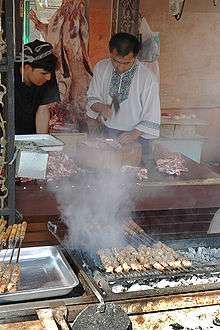 Ürumqi, Xinjiang kebab street stand
Ürumqi, Xinjiang kebab street stand
See also
Notes
References
- ↑ Raichlen, S.; Fink, B. (2008). The Barbecue! Bible. Workman Pub. pp. 157–158. ISBN 978-0-7611-4943-9. Retrieved May 23, 2016.
- ↑ Raichlen, S. (2015). Planet Barbecue!: 309 Recipes, 60 Countries (in German). Workman Publishing Company. p. 251. ISBN 978-0-7611-6447-0. Retrieved May 26, 2017.
- ↑ "recipe". Retrieved 2 November 2014.
- ↑ DK Eyewitness Travel Guide: Cyprus. DK Publishing. 2010. p. 174. ISBN 978-0-7566-7405-2. Retrieved May 26, 2017.
- ↑ To Vima (in Greek), 6-2-2011 (picture 2 of 7)
- ↑ Ancient Greeks Used Portable Grills at Their Picnics, LiveScience
- ↑ How to Cook Like a Mycenaean, Archaeology Magazine
- ↑ Homer, "Iliad" 1.465, on Perseus Digital Library
- ↑ Ancient Wine, Patrick E. McGovern
- ↑ Wright, Clifford A. (1999). A Mediterranean Feast. New York: William Morrow. pp. 333.
- ↑ Grigson, Jane (1983-01-01). Jane Grigson's book of European cookery. Atheneum. ISBN 9780689113987.
Kebabs were as popular among the ancient Greeks as they are today. Homer tells us how Achilles organised a barbecue when he had envoys from Troy to dinner.
- ↑ ὀβελίσκος, Henry George Liddell, Robert Scott, A Greek-English Lexicon, on Perseus, dim. of ὀβελός (obelos), ὀβελός, ibid.
- ↑ Jack, Albert (2010-09-02). What Caesar Did For My Salad: The Secret Meanings of our Favourite Dishes. Penguin Books Limited. ISBN 9780141929927.
ancient Greeks from Homer to Aristophanes wrote about an earlier variant of the kebab, the obeliskos (meaning 'little spit' [...]
- ↑ Acharnians 1007
- ↑ Matalas, Antonia-Leda; Yannakoulia, Mary (2000). "Greek Street Food Vending: An Old Habit Turned New". In Simopoulos, Artemis P.; Bhat, Ramesh Venkataramana. Street Foods. Karger Medical and Scientific Publishers. p. 6. ISBN 978-3-8055-6927-9.
- ↑ "The Gyro, a Greek Sandwich, Selling Like Hot Dogs". The New York Times. September 4, 1971. p. 23. Retrieved February 22, 2016.
- ↑ Tassoula Eptakili (2015-10-09). "Prehistoric Gastronomy". Greece Is. Retrieved February 21, 2016.
- ↑ Gold, David L. (2009). Studies in Etymology and Etiology With Emphasis on Germanic, Jewish, Romance and Slavic Languages. Universidad de Alicante. p. 323. ISBN 978-84-7908-517-9.
- ↑ "Souvlaki (Wicked kebabs)". Jamie Oliver Recipes. Retrieved February 22, 2016.
- ↑ Flores, E.K. (2016). Adventures in Chicken: 150 Amazing Recipes from the Creator of AdventuresInCooking.com. Houghton Mifflin Harcourt. p. 115. ISBN 978-0-544-55821-2. Retrieved May 26, 2017.
- ↑ "Bihari kabab". ALL THINGS PAKISTAN. Retrieved 2 November 2014.
- ↑ Singh, S. (2009). India. Ediz. Inglese. Country Guide Series (in Turkish). Lonely Planet. p. 262. ISBN 978-1-74220-347-8. Retrieved May 26, 2017.
- ↑ Oseland, J.; Magazine, E.S. (2011). Saveur: The New Comfort Food: Home Cooking from Around the World. Chronicle Books LLC. p. 124. ISBN 978-1-4521-0539-0. Retrieved May 26, 2017.
- ↑ "Dora kabab". Khaleej Times. October 22, 2015. Retrieved May 26, 2017.
- ↑ India Today. Thomson Living Media India Limited. 2001. p. 163. Retrieved May 26, 2017.
- ↑ Kraig, B.; Sen, C.T. (2013). Street Food Around the World: An Encyclopedia of Food and Culture. ABC-CLIO. p. 176. ISBN 978-1-59884-955-4. Retrieved May 26, 2017.
- ↑ "8 meatilicious kebabs you must try out immediately". India Today. May 11, 2016. Retrieved May 26, 2017.
- ↑ Banerji, C. (2008). Eating India: An Odyssey into the Food and Culture of the Land of Spices. Bloomsbury Publishing. p. 125. ISBN 978-1-59691-712-5. Retrieved May 26, 2017.
- ↑ Chaturvedi, A.; Kanwar, D.; Sengupta, R. (2013). DK Eyewitness Travel Guide: Delhi, Agra and Jaipur. DK Publishing. p. 253. ISBN 978-1-4654-1492-2. Retrieved May 26, 2017.
- ↑ Kalra, J.I.S.; Das Gupta, P. (1986). Prashad: Cooking with Indian Masters. First Edition. Allied Publishers Private Limited. p. 20. ISBN 978-81-7023-006-9. Retrieved May 26, 2017.
- ↑ Kapoor, S.; Kapoor, A. (2009). Marwari Vegetarian Cooking (in German). Popular Prakashan. p. 25. ISBN 978-81-7991-399-4. Retrieved May 26, 2017.
- ↑ World, E.Y.; Siciliano-Rosen, L.; Rosen, S. (2014). Delhi Food and Travel Guide: The inside scoop on the best North Indian foods in Delhi. 107. Eat Your World. p. pt51. Retrieved May 26, 2017.
- ↑ DK Eyewitness Travel Guide: Delhi, Agra & Jaipur. DK Publishing. 2015. p. 248. ISBN 978-1-4654-4945-0. Retrieved May 26, 2017.
- ↑ DK Eyewitness Travel Guide: Delhi, Agra & Jaipur. DK Publishing. 2015. p. 246. ISBN 978-1-4654-4945-0. Retrieved May 26, 2017.
- ↑ "Reshmi Kebab (Silken Kebabs)". Allrecipes.com. Retrieved 2 November 2014.
- ↑ "Streetfood - Adam's Kabab (Phears Lane, Chuna Gali, near Central Metro station, Kolkata)". 22 October 2012.
- ↑ Marks, Gil (2010). Encyclopedia of Jewish Food. Houghton Mifflin Harcourt. ISBN 978-0-544-18631-6.
- ↑ "Kuwait News Agency (KUNA)". Retrieved 2 November 2014.
- ↑ The Cooking of the Middle East, Time-Life Books (1969)
- ↑ Raichlen, S.; Fink, B. (2008). The Barbecue! Bible. Workman Pub. p. 226. ISBN 978-0-7611-4943-9. Retrieved May 26, 2017.
- ↑ Pakistan, Chemical Society of (2008). Journal of the Chemical Society of Pakistan. Chemical Society of Pakistan. p. 750. Retrieved May 26, 2017.
- ↑ Raichlen, S.; Fink, B. (2008). The Barbecue! Bible. Workman Pub. p. 163. ISBN 978-0-7611-4944-6. Retrieved May 26, 2017.
- 1 2 3 4 5 6 7 8 9 Turkish Cookery by M.Günür ISBN 975-479-100-7
- ↑ Tatlıdan, tuzluya Türk sofrası: alaturka - alafranga ; yemekler ve tatlılar. Geçit Kitabevi. 1982.
- ↑ "Three Renowned Turkish Restaurants: Beyti Meat Restaurant". Skylife - Turkish Airlines magazine (12): 1–4. 2000.
- ↑ Banu Atabay. Mütevazi Lezzetler Deutsch. Banu Atabay. pp. 98–. GGKEY:QQKUPZ6WZ7J.
- 1 2 3 4 5 6 The Complete Book of Turkish Cooking, A.Algar (1985) ISBN 0-7103-0334-3
- ↑ Metin Sözen (2005). Taşın belleği Mardin. Yapı Kredi Kültür Sanat Yayıncıkık. ISBN 978-975-08-1029-9.
- ↑ Rosemary-Lime Wild Alaska Salmon Kabobs | Whole Foods Market
External links
| Wikimedia Commons has media related to Kebabs. |
| Wikimedia Commons has media related to Skewers. |
- Kebab at the Open Directory Project
_2.png)



